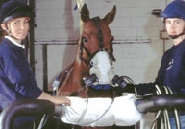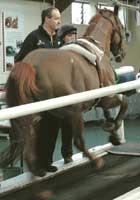When performing strenuous exercise, such as going for a run, the body responds in a number of ways. Most noticeably, the heart beats faster and breathing becomes more pronounced. This is all to do with getting more oxygen into the body to produce the energy needed for exercise; breathing deeply delivers more oxygen into the lungs, and an increased heart rate allows the blood to carry oxygen from the lungs to the muscles more quickly. Animals such as horses need large amounts of oxygen to run fast and have adaptations that make them very efficient at getting oxygen into the body. They have a large diameter airway and nostrils that dilate during exercise to offer low resistance to air entering the and leaving the nose.
Sometimes, however, the airway can become partially obstructed, reducing the flow of oxygen and consequently reducing exercise performance. In humans, it is partial obstruction of the arway that causes snoring, but as we tend not to be exercising when we snore the limitation it would impose on our exercise performance is not of concern. In racehorses, however, the airway can become partially obstructed during a race, and this can cause an immediate and serious loss of performance. The University of Bristol Equine Centre is one of a small number of centres within the UK that specialises in the diagnosis and treatment of equine respiratory conditions. Diagnosis is made on the basis of visual identification of obstructions as they occur during exercise. Horses are galloped on a high-speed horse-sized treadmill, whilst the airway is observed using an endoscope passed up the nose.
A few years ago we noticed that the diagnoses were being anticipated by our technicians, who hold the horses and encourage them to run on the treadmill. From their position close to the horse’s head the technicians were able to hear the breathing sounds produced by the horses and had associated certain sounds with specific diagnoses. Superficially, these observations can be explained using basic mechanical principles: anatomically, airway obstructions are soft-tissue structures that would readily vibrate in an airflow similar to a flag flapping in the wind. Some of these tissues, such as those in the larynx, are quite rigid, whereas those in the soft palate are more flexible. This difference in rigidity causes structures to vibrate at different rates and hence generate different sounds.
The diagnoses were being anticipated by our technicians
We decided that if we could quantify the sound of horses breathing, we might be able to characterise the sounds produced by different types of obstruction. Accordingly, we built a recording system that used a miniature microphone positioned near the end of the horse’s nose to obtain breathing sounds. Over a period of approximately one year we listened to horses that were referred to the University Equine Centre with suspected airway obstruction. The human brain is extremely good at processing sounds so there was no guarantee that the skills developed by our technicians could be reproduced using computer software. By extracting the frequencies contained in the sound signal, however, we were able to recognise the sound signature for the most common obstruction of the airway – dorsal displacement of the soft palate.
Although there are still several hurdles to overcome before the sound signatures for all types of equine airway obstruction are recognised, the technique is currently showing promise as a new method of diagnosis. In future, we might be able to obtain a diagnosis by taking the sound measurement system to the racing yard, rather than bringing the horse to the Centre. Consequently, the horse could be tested when on its normal exercise gallop, rather than being trained to run on a treadmill. Collecting enough sound for diagnosis could be completed within an hour and the recording returned to our laboratory for analysis.
Being a good listener to other people’s problems involves knowing how to interpret what we hear. Now that we are able to interpret the information that horses are giving us when we listen to them breathing, we can understand better how to address their problems too.
This work was supported by Tattersalls Ltd.
Jeremy Burn/Department of Anatomy/Equine Centre

